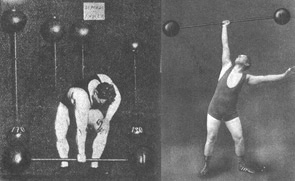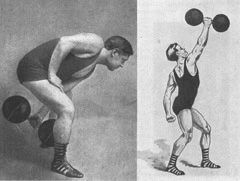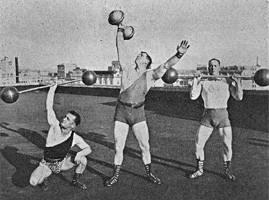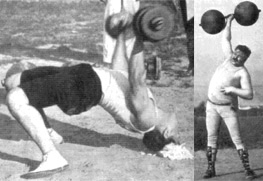What Were The "Standard" Lifts?

American weightlifters trained several competitive lifts at the turn of the century. In the 1904 St. Louis Olympics for example, there were nine one arm lifts, a single two arm lift, and one optional movement included in the weightlifting event! Pictured above are two American Olympic contestants performing the wrestler's bridge and the one arm swing.
During subsequent years, American weightlifters would try to model their sport after the more selective Europeans. In The Truth About Weightlifting (1911), Alan Calvert lists the one arm swing, one arm snatch, one arm jerk, two arm press, and two arm jerk as the primary competitive lifts in Europe. Pictured above is the start and finish of the one arm jerk.

This differs slightly from what Gottfried Schodl has listed in The Lost Past (1992): the one arm snatch, one arm jerk, two arm snatch, two arm press, and two arm jerk. No matter: the one arm lifts would be dropped altogether by the 1928 Olympics leaving just the two arm snatch, press, and jerk for weightlifting competition. Pictured above are the one arm swing and one arm snatch.
Calvert makes note of the American practice (circa 1911) of contesting six to eight individual events in competition, half of which were to be chosen by one's opponent just prior to the event. With dozens of lifts to choose from in America, this sort of format made preparing for one's competition very difficult. Pictured above (l-r) are the two arm snatch, press, and jerk.

Calvert instead favored a standardized weightlifting format of no more than a dozen different movements from which a handful (per the European example) could be chosen and announced well in advance of competition. He also wanted standardized weight categories: a heavyweight class for 180 lbs and up, a middleweight class for 160 - 180 lbs, a lightweight class for 135 - 160 lbs, and a featherweight class for below 135 lbs.
During the early 1920's the American Continental Weight Lifters Association (ACWLA) attempted to organize weightlifting on a national level and selected the following five lifts for their standard competition formats: the one hand clean and jerk, the two hand snatch, two hand clean and jerk, the one hand military press, and the two hand deadlift. This format would only last a short while however, as they soon dropped the deadlift in favor of other movements.

Eventually, the ACWLA was supplanted by the Association of Bar Bell Men (ABBM), which also contested the deadlift in a specialized category consisting of so-called "body lifts". For contest purposes, this group would comprise diverse movements like the deadlift, hip and thigh lift, harness lift, teeth lift, and 2 finger lift. Control of weightlifting in America, however, soon became the province of the Amateur Athletic Union (AAU).
The AAU had been putting on Olympic-style weightlifting events around the country for years and was eventually recognized by the ACWLA and ABBM as the main sanctioning body for these lifts. Ultimately, as both the ACWLA and ABBM were disbanded, the AAU took complete control of all weightlifting matters in this country.

In order to facilitate future competition on an international level, the AAU also fostered a more Europeanized format for the standard American lifts. Accordingly, the following five movements would be used until 1935 (after which only the two arm movements were retained): the one arm snatch, one arm jerk, two arm snatch, two arm press, and two arm jerk. Moreover, the following bodyweight classes would be used throughout the 30's: 112, 118, 126, 132, 148, 165, 181, and Heavyweight.
But what about the "non-standard" movements? Lifters during the 1930's were not limiting their training to just the five exercises they used in AAU competition. Many non-standard lifts (including the power movements) were still being practiced as auxiliary exercises or for exhibition purposes. Of the 50 lifts Bob Hoffman lists in Weightlifting (1939), the AAU kept official records for only the standard lifts. Bob Hoffman took it upon himself however, to keep world, national, district, and state records through the pages of Strength & Health magazine. He even arranged for medals and certificates to be awarded for qualified lifts meeting certain standards of performance. While perusing these standards, take note of the qualifying poundages given for the deep knee bend (squat), dead lift, and press on box (bench press).
